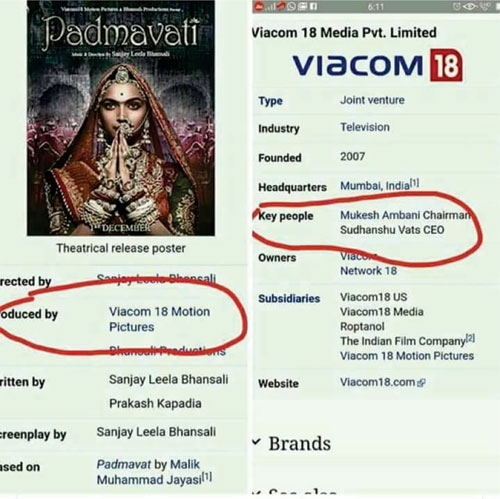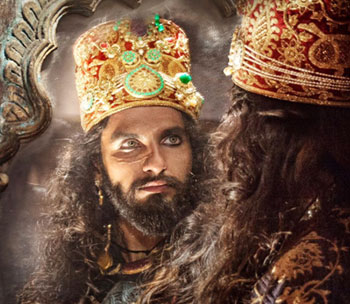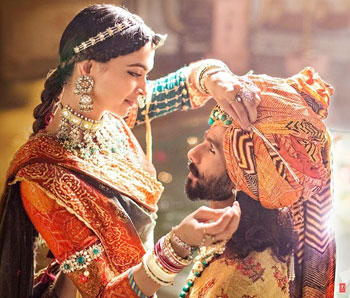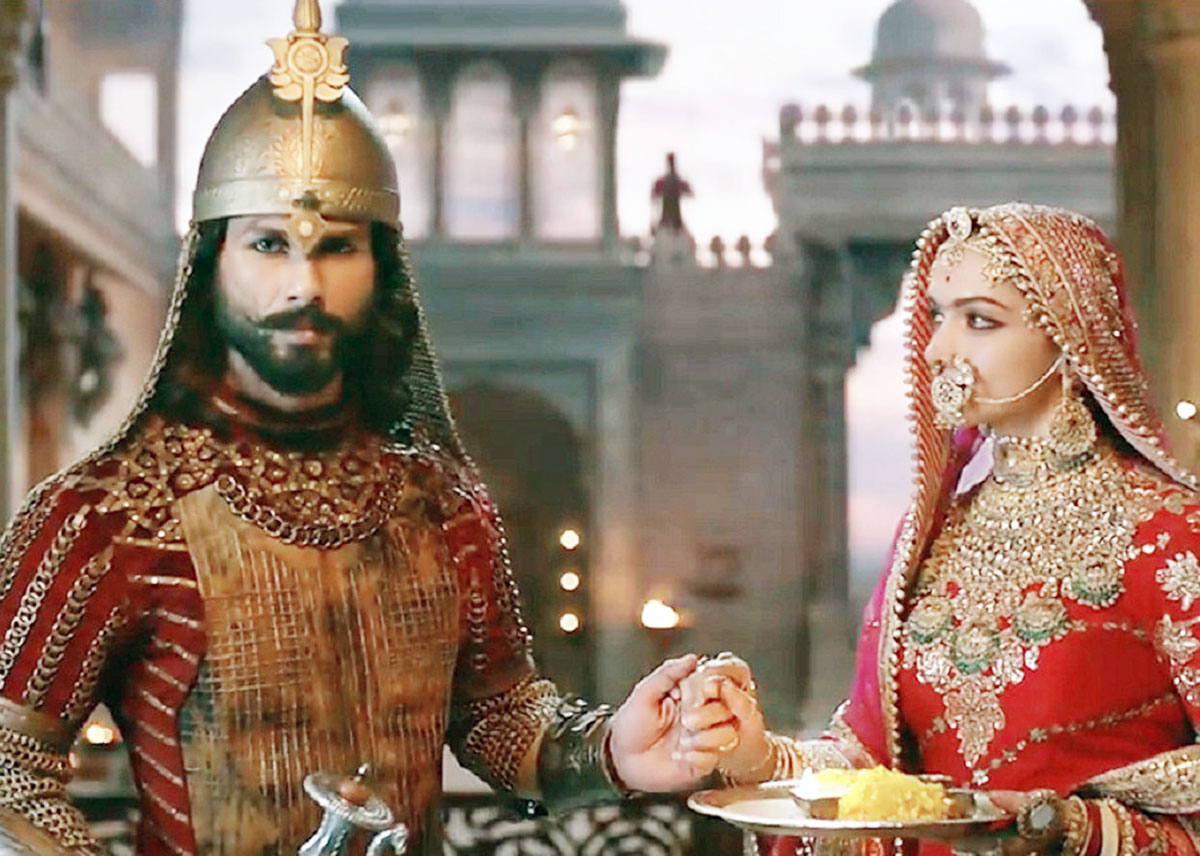Unmasking Padmavati “How Jaisi’s anti-feudal tale is twisted to push a fascist narrative”
 Historical accounts do not mention a word about Padmavati or that Allaudin Khilji attacking Chittor after hearing about the beauty of the legendary queen, writes eminent historian and author AMARESH MISRA.
Historical accounts do not mention a word about Padmavati or that Allaudin Khilji attacking Chittor after hearing about the beauty of the legendary queen, writes eminent historian and author AMARESH MISRA.
It is evident from historical accounts, and a reading of the Mahakavya Padmavat, written by Malik Mohammad Jaisi, the 16th century Awadhi poet, that the story of Rani Padmavati does not include the Allauddin Khilji Vs Rajput honour binary. Malik Muhammad Jayasi, the Sufi mystic, wrote Padmavat in 1540 AD. The Chittor incident ‘involving Padmavati’ took place around 1303 AD.
No Allauddin-Rajput Honour Binary
Historical accounts do not mention a word about Padmavati or Allaudin Khilji attacking Chittor after hearing about the beauty of the legendary queen. Amir Khusro, the famous Sufi inventor of Hindustani classic music, several musical instruments, the father of Khari Boli, which later evolved into Hindi and Urdu, accompanied Allauddin Khilji during the Chittorgarh campaign. Khusro was also one of the earliest compiler of history in India.
In Khaza’in ul-Futuh (The Treasures of Victories-1296), Khusro gives details of Allauddin Khilji’s construction works, wars, and administrative services. According to Khusro, the ruler of Chittor surrendered before Khilji–and Khilji pardoned him off. This account is confirmed by other historians like Ziauddin Barani who wrote later, in the mid to late 14th century.
 Also See: Facing Tough Fight in UP Local Body Polls, Yogi Jumps into ‘Padmavati’ Row
Also See: Facing Tough Fight in UP Local Body Polls, Yogi Jumps into ‘Padmavati’ Row
Contemporary accounts include ‘History of Khaljis (1290-1320)’ by Kishori Lal Saran (Asia publishing house, 1967), ‘Northern India under the Sultanate: Agrarian Economy’ by Irfan Habib, ‘The Khaljis: Alauddin Khalji’ in ‘A Comprehensive History of India: The Delhi Sultanat (A.D. 1206-1526)’ by Benarsi Prasad Saxena. They too confirm the historical reality laid out by Khusro.
‘Jauhar’ happened in Ranthanbore, not Chittor
Surprisingly, ‘Jauhar’ of women is part of Allauddin Khilji’s conquest of Ranthambore, not Chittor–and that too in 1301 (Chittor was attacked in 1303)!
One of Allauddin Khilji’s major contribution was preventing Mongols from taking over India. From Baghdad to Europe, Russia and China, Mongols had conquered almost the entire world. First Balban in 1260s, and then Alauddin Khilji in 1290s and early 1300s, stopped Mongol advance into India and shattered the aura of their invincibility.
Khilji broke the back of Mongols by defeating them repeatedly, at Jaran-Manjur (1297-1298), Sivistan (1298), Kili(1299), Delhi (1303), and Amroha (1305). In 1306, his forces achieved a decisive victory against the Mongols near the Ravi riverbank, and in the subsequent years, his forces ransacked the Mongol territories in present-day Afghanistan.
Conflict with Ranthambore was triggered off when two rebel Mongol leaders–Muhammad Shah and Kabhru–managed to escape with some of their followers. Hammira, the ruler of Ranthambore (called Hamir Dev in Muslim chronicles), granted asylum to these Mongol fugitives.
The Ranthambor seige was long and bloody. Hammira’s fort was considered impregnable. Alauddin Khilji won because of his superior technology. He possessed giant machines that launched ‘missiles’ or large projectiles. Khilji also filled the defensive ditch around the fort with mounds of sewn sacks, or pashebs.
 Muslim Mongols led Rajputs against Khilji
Muslim Mongols led Rajputs against Khilji
Contrary to what right wingers purport, alongwith Rajput generals, Muslim Mongols led Ranthambor forces. So much so that Muhammad Shah accompanied Hammira in his last stand. Amir Khusro and other chroniclers mention Muslim ladies committing Jauhar alongside Hammira’s wives and Rajput ladies!
On the other hand, Rajput bardic traditions like Hammira Maha Kavya, talk about Bhoja, Hammira’s brother, and Ritipala, Hammira’s ‘trusted’ general, crossing over to Khilji’s side. Bards also state how Sarjan Shah, a Buddhist merchant, who held personal grouse against Hammira, poisoned food provisions inside the Rajput fort.
Khilji’s assault was part of a political drive. In this process, the Delhi emperor subjugated kingdoms of Gujarat (raided in 1299 and annexed in 1304), Ranthambore(1301), Chittor (1303), Malwa (1305), Siwana (1308) and Jalore (1311).
Padmavat: Jaisi’s fictional-allegorical epic
Malik Mohammad Jaisi was a poet of the Bhakti-Sufi movement. He belonged to Jais, a Qasabah in present-day Rae Bareilly district of Awadh, Uttar Pradesh.
Around 1540 AD, Jaisi wrote Padmavati, his epic poem, in Awadhi language. Like Anarkali and Jodha Bai, Padmavati is a piece of literature. As literature, Jaisi’s rendition of the Rani Padmavati story blends facts, fiction, imagination to create an emotional-devotional epic of love and the futility of desire, ambition, and in Jaisi’s own words, the irredeemable quality of Maya or illusion. Jaisi seems to blend the Ranthambor Jauhar and the Chittor incident, both involving Allauddin Khilji, with prevalent legends about Padmini, the queen of Singhaldweep (Srilanka).
For Jaisi, Allauddin Khilji represents Maya. Chittor is the body; Rana Ratan Sen is the mind and Rani Padmini is not just beauty–she is also the symbol of intelligence (Buddhi):
Desire, love and illusion
But even Maya or mind or intelligence are just props–Jayasi in Padmavat ponders upon the world’s transitory nature. How love and illusion clash; how, while love is true, desire is delusional. Desire objectifies or reifies love and sees the subject of love, in this case Rani Padmini, as an object. In this one act, desire transforms love into its opposite.
From being its intimate subject, desire transforms love into something independent of emotions of lovers–a ‘piece’ of flesh that has to be captured. As such, the autonomy or subjectivity, the humanness, of that ‘piece’ of flesh, is destroyed.
Padmavat, Chivarly, Feudalism…and Khilji’s tragedy
Jaisi projects Allaudin Khilji, not as an aggressor or a savage King, but a normal man, in fact, a victim of his desires and illusions, who cannot fathom the higher workings or laws of fate or nature and how his objectification of Padmini destroys the possibilities of him ever having her as his consort! For, objectification makes a subject ‘public property’. In a feudal-set up, this is akin to going against the basics of late-feudal ethics of chivalry. Feudalism is used to subvert feudalism.
In Padmavat, Khilji does not get the satisfaction of dueling with Ratan Sen, Rani Padmini’s husband, for her hand. His desire objectified Padmini as feudal property; now others too seek her hand. Let alone history, even in Jaisi’s Mahakavya, Ratan Sen is killed NOT BY KHILJI’S SWORD, but in a duel with DEVPAL, the HINDU RAJPUT Raja of Kumbhalner, who too is seeking Padmini’s hand!.Khilji comes off, ultimately, as a disillusioned, tragic figure.
Jaisi’s Padmavat as Anti-Feudal literature
Chivarly in Europe emerged in literature as a theme of personal love set against the notion of women as feudal property of a husband or a household. Jaisi wrote Padmavat in the 16th century–a period in Asia and India, when feudal tendencies were giving way to early proto-bourgeois-progressive impulses.
Jaisi’s Padmavat thus has to be seen at par with classics of European tales of chivalry. Sher Shah Suri sat on Delhi’s throne during Jaisi’s time. Akbar was to follow Suri–and both these rulers of different dynasties transformed India from a land of petty principalities into a modernising kingdom that broke several feudal practices.
Ram Charit Manas
By subjectivising Ram, Tulsidas, too freed religious idols from their earlier position as property of the feudal temple, to nodal points of personal love and devotion of the masses. That is the reason orthodox Kashi Pandits were against Tulsidas–the latter was attacking feudal preserves, freeing gods for the people.
Significantly, Tulsidas followed Jaisi, in the 16th century. Both wrote in Awadhi. Padmavat and Ram Charitmanas thus, fulfill the urges of early modernism in India. In fact, in the 17th century, Gods became truly subjective, sensual and bourgeois, especially in the reetkaal poetry patronised by Jehangir and Shahjahan.
 14th Century in History
14th Century in History
In Europe, with the advent of early renaissance and subjectivity in painting, anti-feudal currents start emerging in the 14th century itself. In India as well, Alauddin Khilji’s era is seen as the first attempt by a Delhi monarch to unite the sub-continent after feudal disruptions of the Post-Gupta era. From Kara in Allahabad to Dipalpur in Punjab, Khilji built roads and irrigation systems. He suppressed local landlords. Before Sher Shah Suri or Akbar, it was Khilji who began maintaining a central army instead of feudal retainers. Khilji also started a land survey and direct tax settlement of the State with the peasant.The Cambridge Economic History of India states categorically that “Alauddin Khalji’s taxation system was probably the one institution from his reign that lasted the longest, surviving indeed into the nineteenth or even the twentieth century. From now on, the land tax (kharaj or mal) became the principal form in which the peasant’s surplus was calculated…”
Khilji’s reforms and ‘Pro-Hindu’ tilt
Khilji fixed prices of commodities, created centralized markets and a supply chain of exchange between the town and the countryside.
Anticipating Akbar again, Khilji was the first ruler to marry two Hindu Princesses, Kamaladevi (belonging to the Vaghelas of Gujarat) and Jhatyapali (daughter of Ramachandra, the King of Deogiri).
Initially, in his reign, Allauddin Khilji destroyed BOTH temples and mosques of recalcritant Hindu and Muslim Rajas. Then, he began a policy of compromise with Hindu chiefs, willing to accept his suzerainty.
In a 1305 document, Amir Khusro mentions that Alauddin treated Hindu zamindars kindly, and granted more favours to them than they had expected. This policy of compromise with Hindus was greatly criticized by a small but vocal set of Muslim extremists, as apparent from Barani’s writings.
Muslim opposition to Khilji
Apparently, Akbar was not the first Emperor to start a new religion. Khilji too fiddled with the idea. Ziauddun Barani wrote disapprovingly that Alauddin did not patronize the Muslim Ulema, and “his faith in Islam was firm like the faith of the illiterate and the ignorant”.
Barani further states that “Alauddin once thought of establishing a new religion…just like the Islamic prophet Muhammad’s four Rashidun caliphs helped spread Islam, Alauddin believed that he too had four Khans(Ulugh, Nusrat, Zafar and Alp), with whose help he could establish a new religion…”
As per Barani, the latter’s uncle Alaul Mulk convinced Khilji to drop this idea, stating that a new religion could only be found based on a revelation from god, not on human wisdom.
Upon Khilji’s death in 1316, Qutubuddin Shah, son of Khilji’s Hindu wife, was given preference over others by Malik Kafur, an Indian Muslim convert, and Khilji’s closest aide.
Literature inverts history
Jaisi’s Khilji represents feudal desire for property. Ratan Singh and Padmavati typify progressive-bourgeois sentiments. In reality, Ratan Sen marked feudal property sense while Khilji is the moderniser.Such inversions happen in literature.Shakespeare imparted a tragic individuality to Brutus and other failed ‘democrats’ in Julius Ceasar, his 16th century Elizabethan era play. But in actual Roman history, the senators who railed against Ceasar represented the old order while the Roman King himself was a moderniser.
Anti-Feudal tale turns pro-Feudal under British supervision.
At least two other versions on the Rani Padmini legend appeared after Jaisi. But it was James Todd–the dubious ‘officer-historian’ of the colonial school, the one falsifying/re-inventing Rajput history to suit British needs–who moulded Allauddin Khilji as a demonic, Muslim villain. In ‘Annals and Antiquities of Rajasthan’, Todd presented, for the first time, KHILJI VS RAJPUT HONOUR BINARY!
‘Annals…’ sets into motion the transformation of Rani Padmini’s story from a critique of feudalism into upholding the glory of feudalism where ‘Jauhar’ reflects the epitome of feudal honour!
In Jaisi’s version, as in other Persian, Urdu or even pre-Todd Rajput versions, Rani Padmini’s story is one of love…and Jauhar symbolises spiritual negation of the feudal propensity to usurp the (female) human body as property: how objects of feudal desires (not related to love) become unattainable…and turn, in the last instance, to ashes!
It is another matter that even Todd was not convinced that Ratan Sen was the name of Rani Padmini’s husband. Todd gives his name as Laxmansimha.
Colonialism, Fascism and Bhansali’s Padmavati
Fascism imposes feudal values in a modern, bourgeois setting–something which British colonialism did to India, reversing the Mughal-Rajput-Maratha-Awadh modernity and incipient capitalism, to re-install feudalism in land tenure, the economic base, so that the superstructure–culture and society–too reneges on modern values and lends itself, among other things, to communalism!
As such, Bhansali’s Padmavati can be seen as re-inverting history and literature to suit the ruling class politics (communal fascism) of today.
Bhansali does not represent Khilji as a victim of objectified desire. Bhansali’s Khilji is the mindless, irrational, Muslim other, SEEN FIRST IN TODD, who relishes in his lust and objectification of beauty. Bhansali’s Rani Padmini, is a reified object of fascist times, and neo-colonial-corporate markets that drive those times!
Fascism is a late bourgeois phenomenon when the bourgeois system turns against its own progressivism. Under fascism, subjectivism or individualism, a hallmark of progressive bourgeois values, is crushed and suppressed. Politics takes on the reification of the market. The feudal property sense makes an artificial re-entry by displacing the bourgeois private property. As seen with demonetisation etc, fascism attacks small businesses, ‘money’ held by private citizens, individual rights, autonomy etc.
Because of persistence of feudal remnants, India, despite Independence, missed the industrial revolution and healthy capitalism. But a modicum of modern reforms did manage to change the system to a limited degree. But fascism seeks to block even the minimal democratic rights achieved by the Indian Republic.
Karni Sena/Fascist hammering of Padmavati
While purveying certain fascist values, Bhansali’s Padmavati falls prey to fascist machinations itself. A tool of fascism, it is being hammered by fascism doubly, as a tool. Bhansali and karni sena are two sides of the same coin. They both peddle allauddin khilji as the barbaric, ‘muslim’ other! Their collision is for mutual benefit! This is the ultimate grotesque tragedy of Bhansali, and the price he has to pay for turning Jaisi’s modernising ode to love and illusion, into a fascist aesthetic of gaudy grandeur of the villainous other.
The ‘RSS-Rajput’ angle
Politically, the film Padmavati is being used by Sanghis to mobilise Rajputs into a conspiracy against democracy.BJP is losing Gujarat…it will be the beginning of the failure of fascist forces to sustain power through democratic means. The ultimate goal of Sanghis is to stage a coup against Indian democracy and the Republic.
Rajput royals carry a narrative of Rajshahi–they claim that when the British left they gave India to princely states. And that Nehru brought in democracy and spoiled their game.Big Rajput houses of Rajasthan are funding Karni Sena, the outfit that is ‘attacking’ the film. The Sangh too, is supporting Karni Sena.
However, ordinary rajputs have shown no interest in the issue!Among up rajputs, rajasthani rajputs are seen as betrayors of 1857.It is widely believed in up and bihar that rajput honour was actually at stake in 1857. Then, only up-bihar and mp rajputs came forward to defend rajput valour and fight the british.All rajasthani rajput houses supported the british!
 Bhansali’s Padmavati unites Sanghis and Rajput royals in a temporarily alliance against Indian democracy
Bhansali’s Padmavati unites Sanghis and Rajput royals in a temporarily alliance against Indian democracy
As the release date draws nearer, more violence and riots shall occur. One arm of BJP run State power will support Bhansali. The other arm will encourage the Karni Sena. Gujarat has a large percentage of ‘fallen Kshattriyas’–groups who claim Rajput status but are actually closer to OBCs. A big Rajput backlash in Rajasthan will impact Gujarat. This is, at least, what the RSS is planning.
The UP Govt too has jumped into the fray. As per reliable sources, Home Secretary, Uttar Pradesh, has written to the Central Govt that the release of the film will lead to widespread ‘unrest’! Local body polls in UP are due in late November.
The Muslim festival of Barawafat also falls around November end. BJP is not expected to do well in Uttar Pradesh polls. A controversy on Padmavati will help BJP in UP. Or so they think…


